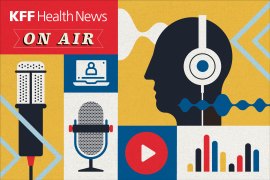Viewpoints: Fake Medical News; The Cost Of Growing Old; Gun Violence’s Toll
A selection of opinions on health care from around the country.
Los Angeles Times:
It's Not Just Politics: 2016 Was An Epidemic Year For Fake News In Science, Too
One of the watchwords of politics in 2016 was the epidemic of “fake news” — a catch-all term encompassing propaganda, misinformation, disinformation and hoaxing — impinging on the presidential campaign. But let’s not overlook its spread in the spheres of science and medicine. That point is made in a recent article by Ivan Oransky and Adam Marcus. ... The No. 1 episode of scientific fake news must be what Oransky and Marcus termed the “cage match of credulity” staged by that noted purveyor of pseudoscience, Dr. Mehmet Oz, and then-presidential candidate Donald Trump in September. The encounter was billed as an inquiry into Trump’s health. But it was a grotesquely misleading program. (Michael Hiltzik, 1/3)
Los Angeles Times:
Not Rich, Not Poor, And Not Ready For The Cost Of Growing Old
Caroline from Sierra Madre wrote to me about the “five-year-long funeral” that followed her father’s stroke, saying “he retired a member of the middle class and died impoverished after all the family funds were spent on care.” Art from Studio City wrote about his 96-year-old father, who has dementia and whose bank account “is evaporating at a fast pace because of the cost of caregivers, food, medicine and daily expenses.” (Steve Lopez, 1/3)
JAMA Internal Medicine:
Responding To Firearm Homicide In Urban Areas
Although mass shootings are horrid events that grip the public attention, they account for relatively few homicides in the United States. Many more people die in everyday shootings in urban areas that may go unnoticed. The victims of firearm homicide are primarily young, male, or black. Of the 10 945 firearm homicides in 2014, 65.8% of the victims were age 15 to 34 years, 84.3% were men, and 57.5% were black. (Robert Steinbrook, 1/3)
The Washington Post:
The Pain Pill Epidemic Isn’t Going Anywhere Until We End Coal’s Dominance
Coal mining is one of the most dangerous jobs in the United States. According to the U.S. Bureau of Labor Statistics, underground bituminous coal miners are three times more likely to suffer serious injuries and illnesses than workers in any other private industry. Many of those I worked with who were abusing were not “pill heads.” They had weighed a difficult choice: take pain medication to be able to continue to work, or risk fighting for disability compensation that’s seldom enough to pay the bills. Those taking medication on the job were often ashamed of their dependency. In many cases, they avoided working in positions that could get someone hurt. (Nick Mullins, 1/3)
Des Moines Register:
A New Year’s Resolution: Reduce Childhood Obesity In Iowa
Unfortunately, there is not enough public awareness about the long-term consequences of childhood obesity, which is destructive to future generations. The medical effects are dangerous, and can lead to fatal complications. However, there are other repercussions to obesity other than the medical issues. Obesity among children causes emotional, social and mental barriers. ... To alleviate childhood obesity, there needs to be a total lifestyle change that includes greater education for younger children, making nutritious food affordable, and more organization dedicated solely to tackling childhood obesity. (Yogesh Shah and Sreelekha Kundu, 1/3)
The Washington Post:
The Man Who Beat Lou Gehrig’s Disease
When Ted was diagnosed in 2010 by Jonathan Glass, a doctor at the Emory ALS Center, he was deteriorating quickly. He could walk only short distances with the help of a cane. Simple tasks, such as getting the mail or walking up the stairs to put his kids to bed, had become impossible for him. ... But two years later, on Oct. 20, 2012, Ted completed Atlanta’s two-and-a-half-mile Walk to Defeat ALS with no difficulty. In fact, Ted completed the ALS walk four years in a row. He ditched his cane and was able once again to play with his kids in the pool and walk up the stairs to tuck them in for bed. (Marc A. Thiessen, 1/3)






